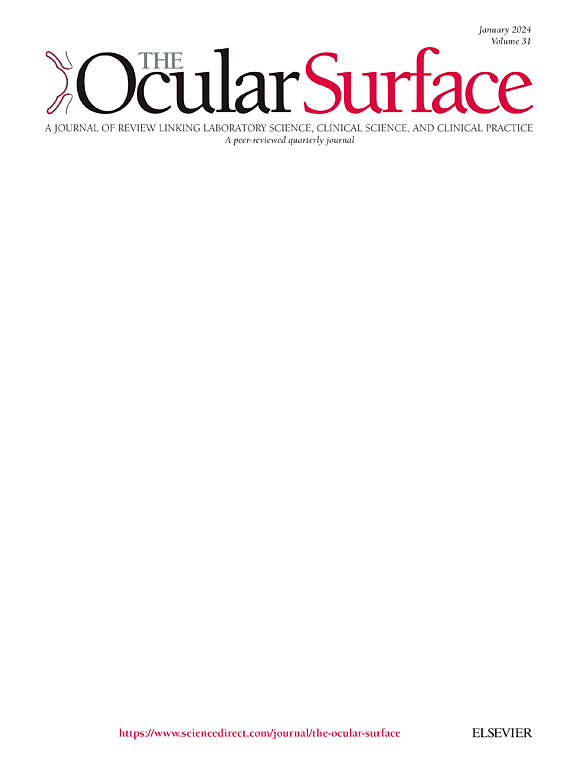当噪音变成信号:使用眼球跟踪器对眨眼率的研究。
IF 5.9
1区 医学
Q1 OPHTHALMOLOGY
引用次数: 0
摘要
目的:虽然眨眼率被认为对数码眼疲劳和干眼症很重要,但其评估大多采用人工方式。本研究旨在使用 Eyelink 1000 Plus 眼动仪自动量化眨眼率,并与人工计数进行比较。此外,眨眼率还与阅读时的眼球运动和阅读速度相关:方法:共招募了 30 名参与者(平均年龄为 26.8±3.5 岁;19 名女性)。屏幕阅读任务持续 3 分钟,重复 3 次,每次之间休息 2 分钟。任务期间,通过 Eyelink 1000 Plus 眼动仪测量眼球运动和眨眼情况。眨眼次数也由检查员通过视频实时手动计数:结果:眼球跟踪仪(中位数[Q1, Q3]:11.7 [6.8, 15.5]次/分钟)和人工计数(11.6 [7.1, 15.4]次/分钟)得出的眨眼率相当(P>0.5)。眨眼次数与任何阅读眼动参数之间都没有明显的相关性,但眼球回转幅度除外(Spearman's rho,rs =0.506)。眨眼次数与阅读速度之间没有统计学意义上的相关性:结论:Eyelink 1000 Plus 眼动仪的眨眼率与人工计数的眨眼率相当。眨眼率与囊状移动幅度之间的正相关可能表明这两种机制之间存在耦合互动,从而最大限度地减少阅读过程中的视觉损失。还可以进一步探索使用这种跟踪器来研究干眼症和双眼视力障碍患者的眨眼情况。本文章由计算机程序翻译,如有差异,请以英文原文为准。
When noise becomes signal: A study of blink rate using an eye tracker
Purpose
Although blink rate is considered important for digital eye strain and dry eye conditions, its assessment has been mostly manual. This study aimed at quantifying blink rate automatically using the Eyelink 1000 Plus eye tracker and comparing it with manual counting. Additionally, blink rate was correlated with reading eye movements and reading speed.
Methods
Thirty participants (mean age 26.8 ± 3.5 years; 19 females) were enrolled. An on-screen reading task for 3 min duration, was repeated 3 times with a 2-min break between the repetitions. During this task, eye movements and blinks were measured through the Eyelink 1000 Plus eye tracker. The blink was also counted manually by the examiner in real time from a video feed.
Results
The blink rate obtained by the eye tracker (median [Q1, Q3]:11.7 [6.8,15.5] blinks/min) and manual counting (11.6 [7.1, 15.4] blinks/min) were comparable (p > 0.5). No significant correlations were observed between the blink rate and any of the reading eye movement parameters except saccadic amplitude (Spearman's rho, rs = 0.506). No statistically significant correlation was found between the blink rate and reading speed.
Conclusion
The Eyelink 1000 Plus eye tracker gives a comparable blink rate compared to that obtained through manual counting. A positive correlation between the blink rate and saccade amplitude could indicate a coupled interaction between the two mechanisms to minimize visual loss during reading. The option of using this tracker to investigate blinks in dry eye and binocular vision disorders can be further explored.
求助全文
通过发布文献求助,成功后即可免费获取论文全文。
去求助
来源期刊

Ocular Surface
医学-眼科学
CiteScore
11.60
自引率
14.10%
发文量
97
审稿时长
39 days
期刊介绍:
The Ocular Surface, a quarterly, a peer-reviewed journal, is an authoritative resource that integrates and interprets major findings in diverse fields related to the ocular surface, including ophthalmology, optometry, genetics, molecular biology, pharmacology, immunology, infectious disease, and epidemiology. Its critical review articles cover the most current knowledge on medical and surgical management of ocular surface pathology, new understandings of ocular surface physiology, the meaning of recent discoveries on how the ocular surface responds to injury and disease, and updates on drug and device development. The journal also publishes select original research reports and articles describing cutting-edge techniques and technology in the field.
Benefits to authors
We also provide many author benefits, such as free PDFs, a liberal copyright policy, special discounts on Elsevier publications and much more. Please click here for more information on our author services.
Please see our Guide for Authors for information on article submission. If you require any further information or help, please visit our Support Center
 求助内容:
求助内容: 应助结果提醒方式:
应助结果提醒方式:


